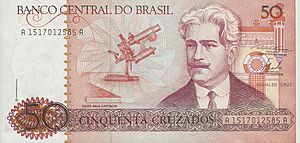Oswaldo Cruz facts for kids
Quick facts for kids
Oswaldo Cruz
|
|
|---|---|
 |
|
| Born |
Oswaldo Gonçalves Cruz
August 5, 1872 São Luís do Paraitinga, São Paulo, Empire of Brazil
|
| Died | February 11, 1917 (aged 44) |
| Nationality | Brazilian |
| Citizenship | Brazilian |
| Alma mater | Federal University of Rio de Janeiro |
| Scientific career | |
| Fields | Physician |
| Institutions | Instituto Oswaldo Cruz |
Oswaldo Gonçalves Cruz (Portuguese pronunciation: [ozˈvawdu ˈkɾus]; August 5, 1872 – February 11, 1917), was a Brazilian physician, pioneer bacteriologist, epidemiologist and public health officer and the founder of the Oswaldo Cruz Institute.
He occupied the fifth chair of the Brazilian Academy of Letters from 1912 until his death in 1917.
Early years
Oswaldo Gonçalves Cruz was born on August 5, 1872, in São Luis do Paraitinga, a small city in São Paulo Province, to the physician Bento Gonçalvez Cruz and Amália Bulhões Cruz. As a child, he moved to Rio de Janeiro with his family. At the age of 15 he started to study at the Faculty of Medicine of Rio de Janeiro and in 1892 he graduated as a medical doctor, with a thesis on water as vehicle for the propagation of microbes. Inspired by the work of Louis Pasteur, who had developed the germ theory of disease, four years later he went to Paris to specialize in bacteriology at the Pasteur Institute, which gathered the great names of this branch of science of that time. He was financed by his father-in-law, a wealthy Portuguese merchant.
Career
Work in Brazil
Cruz found that the seaport of Santos was ravaged by an epidemic of bubonic plague that threatened to reach Rio de Janeiro, and engaged himself immediately in the combat of this disease. The mayor of Rio de Janeiro authorized the construction of a plant for manufacturing the serum against the disease which had been developed at the Pasteur Institute by Alexandre Yersin and coworkers. He asked the institution for a scientist who could bring this know-how to Brazil. The Pasteur Institute responded that such a person was already available in Brazil: Oswaldo Cruz.
On May 25, 1900, the Federal Serum Therapy Institute was created, intended for the production of sera and vaccines against the bubonic plague, with Baron Pedro Afonso as director general and the young bacteriologist Oswaldo Cruz as technical director. The new institute was established in the old farm of Manguinhos at the western shores of Guanabara Bay. In 1902, Cruz accepted the office of director general of the institute and soon expanded the scope of its activities, now no longer restricted to the production of sera but also dedicated to basic and applied research and to the building of human resources. In the following year, Cruz was appointed director general of Public Health, a position corresponding to today's Brazilian Minister of Health.
Using the Federal Serum Therapy Institute as a technical-scientific base, he embarked on a quick succession of important sanitation campaigns. His first challenge was a series of yellow fever endemics, which had earned Rio de Janeiro the sinister reputation of 'Foreigners' Grave'. Between 1897 and 1906, 4,000 European immigrants had died there from the disease. Cruz pursued the new technique of eradicating mosquitoes and their breeding grounds, fumigating houses, and isolation of the ill. There was opposition to the campaign by many, including physicians, the military, and the poor, but the campaign was successful. Cruz was initially successful in the sanitary campaign against the bubonic plague, to which end he used obligatory notification of cases, isolation of sick people, treatment with the sera produced at Manguinhos and extermination of the rats populating the city.
Later work
Among the international scientific community, his prestige was already uncontested. In 1907, on occasion of the 14th International Congress on Hygiene and Demography in Berlin, Cruz was awarded with the gold medal in recognition of the sanitation of Rio de Janeiro. In 1909, he retired from the position as director general for Public Health, dedicating himself exclusively to the Manguinhos Institute, which has been named after him. From the institute he organized important scientific expeditions, which allowed a better knowledge about the health and life conditions in the interior of the country and contributed to the colonization of regions. Cruz eradicated urban yellow fever in the state of Pará. His sanitation campaign in the state of Amazonas allowed the completion of construction of the Madeira-Mamoré railroad, which had been interrupted due to the great number of deaths from malaria and yellow fever among the workers.
In 1913, Cruz was elected a member of the Brazilian Academy of Arts and Letters. In 1915, due to health problems, he resigned from the directorship of the Oswaldo Cruz Institute and moved to Petrópolis, a small city in the mountains near Rio. On August 18, 1916, he was elected mayor of that city and outlined an extensive urbanization project he would not see implemented.
Death and legacy
In the morning of February 11, 1917, at 44 years of age, he died of kidney failure in Petrópolis, Rio de Janeiro state.
As a consequence of the short, fruitful life of Oswaldo Cruz, an extremely important scientific and health institution was born, which marked the beginning of experimental medicine in Brazil in many areas. To this day it exerts a strong influence on Brazilian science, technology and public health.
In Brazil, several neighborhoods, schools, and public institutions are named after him. Some examples are the neighborhood of Oswaldo Cruz, Rio de Janeiro, the Rodovia Oswaldo Cruz in São Paulo, and the aformentioned health institute Oswaldo Cruz Foundation.
See also
 In Spanish: Oswaldo Cruz para niños
In Spanish: Oswaldo Cruz para niños


